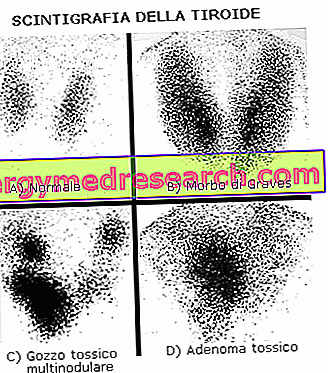| Scintigraphy | Bone scintigraphy | Thyroid scintigraphy | Myocardial scintigraphy |
Scintigraphy is a diagnostic imaging technique based on the detection of radiation emitted by the body after the administration of radioactive drugs. These signals, properly processed and recorded by a computer, allow to effectively investigate the location, shape, size and functionality of some organs, including thyroid, heart, bones, brain, liver, kidneys and lungs. Therefore, the device that performs the scintigraphy does not emit radiation, but merely receives it from the patient's organs in which the tracer is concentrated.
The radioactive isotopes used in scintigraphy as a source of radiation are not used as such, but are associated with specific drugs that, once administered, are distributed mainly in the districts of the organism being studied. Therefore, the role played by the radioactive source (tracer) is purely passive, while the distribution and interaction with the organism depend on the biochemical or pharmaceutical substance to which it is linked.

Is the exam painful? What are the risks involved? Are there any contraindications?
Scintigraphy is a simple and painless technique, although often the radioactive or radiopharmaceutical tracer should be administered intravenously. Among the most used isotopes, there are iodine 131 and colloidal gold 198 for liver investigations, chromium 51 for the examination of the spleen, albumin labeled with iodine 131 for the brain investigation. The doses of isotopes administered are very low and do not involve significant risks for the patient, even if the use of the scintigraphic technique remains contraindicated in pregnancy. For precautionary purposes, moreover, in women of fertile age the scintigrafia is generally carried out within the ten days following the beginning of the last menstruation, so as to exclude the risk of a pregnancy in course. During lactation some radioactive substances may pass into breast milk; therefore, at the discretion of the physician specialized in nuclear medicine, scintigraphy can be postponed or performed unless suspension of breastfeeding is more or less prolonged. Scintigraphy can also be performed on children (the amount of drug used is proportional to body weight) and repeated over time to assess the course of a disease.
The tracers used should not be confused with contrast media; unlike these, allergic reactions to radiopharmaceuticals are extremely rare.
How is scintigraphy performed?
Generally a specific preparation is not required, although in some cases - according to the doctor's instructions - fasting or the suspension of some drugs may be necessary. Therefore it is a good rule to follow scrupulously the instructions received from the health personnel at the time of booking. During the scintigrafia it is necessary to remove the metallic objects.
The scintigraphic examination begins with the administration of the radiopharmaceutical, followed - on the basis of its nature and the anatomic-physiological characteristic that it is proposed to investigate - by a certain waiting period. For thyroid scintigraphy and for myocardial scintigraphy, for example, this time interval is around 20-60 minutes, while for bone scintigraphy a waiting period of three hours is required. To locate an infection or for scintillations with iodine 131, the waiting period is prolonged up to a few days.
Tracer administration is almost always done with an intravenous injection, more rarely by mouth (capsules) or by aerosol. After the appropriate wait, the exam is then performed on a fixed bed, in which the patient is made to sit or lie down; therefore, the heads of the appliance (called gamma camera) will perform rotary or translational movements around the body; being an open instrumentation there is no problem for people suffering from claustrophobia.
If the waiting times after injection of the radiopharmaceutical are excluded, scintigraphy is a relatively short examination, varying from a few minutes for the thyroid examination to 20-30 minutes for that of bones and heart. The duration of the survey is not related to the degree of exposure to radiation, which instead depends on the type and amount of tracer administered.
At the end of the scintigraphy the exam can immediately resume its usual activities, without particular precautions; the doctor can, however, invite him to drink more fluids than usual to facilitate the elimination of the radiopharmaceutical; after using the toilet it is good to let the water flow thoroughly and wash your hands thoroughly. In the first hours after the scintigrafia, always for precautionary purpose (the absorbed radiations are not so dangerous, but it is however correct to conserve superfluous irradiations), the patient should avoid a close contact with small children and pregnant women.



